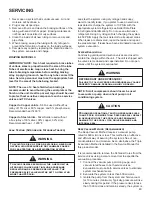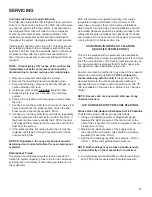
SERVICING
58
Two Piece Air Handler External Static Pressure
To determine proper airflow, proceed as follows:
1. Using a Inclined Manometer or Magnehelic gauge,
measure the static pressure between the outlet of the
evaporator coil and the inlet of the air handler, this will
be a negative pressure ( for example -.30”wc)
2. Measure the static pressure of the supply duct at the
outlet of the unit, this should be a positive pressure (for
example .20”wc).
3. Add the two readings together (for example -.30”wc +
.20”wc = .50”wc total static pressure.
NOTE: Both readings may be taken simultaneously
and read directly on the manometer if so desired.
4.
Consult proper air handler airflow chart for quantity of
air (CFM) at the measured external static pressure.
Maintenance
Motors
Indoor and Outdoor motors are permanently lubricated and
do not need additional oiling.
Cleaning Outdoor Coil
1. Check for oil deposits on coil this could be an indication
of possible leak. If no leak detected spray coil with
ordinary household detergent.
2. Using garden hose, spray coil vertically downward with
constant stream of water at moderate pressure. Keep
nozzle at a 15- to 20° angle, about 3 in. from coil face.
Spray so debris is washed out of coil and base pan.
3. Reinstall top cover and position blade.
4. Reconnect electrical power and check for proper
operation.
Cleaning Outdoor Fan Blade
1. Check balance weights on fan blade.
2. Check fan blade setscrew for tightness.
Electrical Controls and Wiring
1. Disconnect power to both outdoor and indoor units.
2. Check all electrical connections for tightness.
3. Tighten all screws on electrical connections.
4. Connections that appear to be burned or smoky should
be disassembled and cleaned all parts.
5. Wire connections that appear burned and corroded
should be replaced and crimp tightly to assure they do
not overheat.
6. Reconnect electrical power to indoor and outdoor units
and check for proper operation.
Cleaning Aluminum Coils
Evaporator coils and air handlers are equipped with an
aluminum tube evaporator coil. The safest way to clean the
evaporator coil is to simply flush the coil with water. This
cleaning practice remains as the recommended cleaning
method for both copper tube and aluminum tube residential
cooling coils.
An alternate cleaning method is to use one of the products
listed in the technical publication TP-109 (shipped in the
literature bag with the unit) to clean the coils. The cleaners
listed are the only agents deemed safe and approved
for use to clean round tube aluminum coils. TP-109 is
available on the website in Partner Link > Service Toolkit.
NOTE: Ensure coils are rinsed well after use of any
chemical cleaners.
Summary of Contents for ASXC16
Page 4: ...PRODUCT IDENTIFICATION 4 ...
Page 5: ...PRODUCT IDENTIFICATION 5 ...
















































